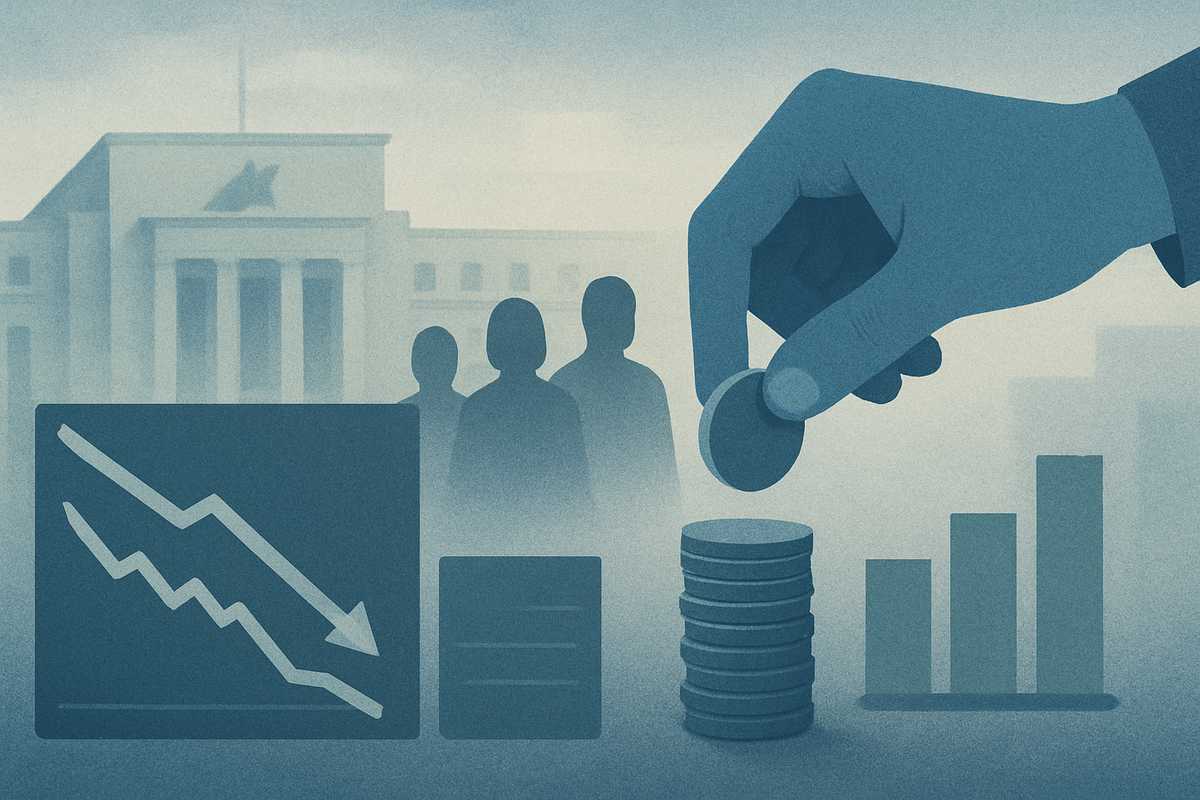
Washington D.C. – October 15, 2025 – The Federal Reserve's latest Beige Book report, released today, paints a nuanced picture of the U.S. economy, indicating largely unchanged overall activity but with clear signs of emerging weaknesses beneath a seemingly stable surface. While employment levels have remained generally steady, the report highlights a significant cooling in labor demand, an increase in headcount reductions through layoffs and attrition, and a noticeable pullback in both consumer and business spending. This mixed bag of economic signals suggests a challenging environment for policymakers and businesses alike, grappling with the implications of a stalled job market and cautious economic behavior.
The report's findings immediately raise questions about the trajectory of the U.S. economy in the coming months. The delicate balance between stable employment and contracting demand could push the Federal Reserve towards a more cautious stance on monetary policy, potentially influencing interest rate decisions as it navigates the twin mandates of price stability and maximum employment. Businesses, meanwhile, are likely to continue adapting to a landscape marked by uncertainty and a discerning consumer base.
A Closer Look at the Evolving Economic Landscape
The October 15, 2025, Beige Book reveals that economic activity across the twelve Federal Reserve districts has been largely stagnant. Three districts reported slight to modest growth, five observed no change, and four indicated a slight softening, underscoring a lack of broad-based momentum. This "stalled job market" or "hiring chill" is a central theme, with employers in most districts reporting a preference for reducing headcounts through a combination of layoffs and attrition rather than actively expanding their workforce.
The reasons behind these headcount reductions are multifaceted, pointing to a confluence of weaker overall demand, heightened economic uncertainty, and, notably, increased investment in artificial intelligence technologies. This suggests a structural shift where AI may be enabling businesses to achieve efficiency with fewer human resources. When hiring does occur, there's a discernible trend towards temporary and part-time workers over full-time positions, indicating a desire for greater flexibility amidst an uncertain outlook. Beyond the labor market, manufacturing activity continues to face challenging conditions, exacerbated by higher tariffs and waning overall demand. Sectors such as retail trade, agriculture, and residential real estate have also experienced declines in activity, further contributing to the narrative of emerging economic weaknesses.
Consumer spending, a critical driver of the U.S. economy, has seen a slight decline, particularly in retail goods. While some areas experienced a temporary boost in auto sales due to demand for electric vehicles ahead of a federal tax credit expiration, overall demand for leisure and hospitality services from international travelers has decreased. Domestic demand in these sectors, however, has remained largely consistent. Of particular note is the behavior of lower- and middle-income households, who are actively seeking discounts and promotions as they contend with rising prices and economic uncertainty, signaling a squeeze on discretionary spending. Business spending has also mirrored this cautious approach, with a slight decline reported in several districts.
Companies Navigating a Shifting Economic Tide
The insights from the Beige Book present a clear divergence in fortunes for public companies across various sectors. Companies heavily reliant on robust consumer spending, particularly in non-essential retail, may find themselves struggling. Retailers like Macy's (NYSE: M) or Nordstrom (NYSE: JWN), which may not be positioned as discount providers, could face continued pressure as consumers prioritize value and seek promotions. Similarly, manufacturing firms, especially those exposed to international trade and higher tariffs, could see their margins squeezed. Companies such as Caterpillar (NYSE: CAT), with significant global manufacturing operations, might experience headwinds from waning demand and trade policy.
On the other hand, certain sectors and companies are better positioned to weather, or even benefit from, these emerging trends. Companies offering efficiency-enhancing technologies, particularly in artificial intelligence, stand to gain as businesses look to optimize operations and reduce labor costs. Firms like NVIDIA (NASDAQ: NVDA) or Microsoft (NASDAQ: MSFT), with their extensive AI offerings, could see increased demand for their solutions. Discount retailers and those catering to value-conscious consumers, such as Walmart (NYSE: WMT) or Dollar General (NYSE: DG), may see resilient demand as lower- and middle-income households stretch their budgets. Additionally, staffing agencies specializing in temporary and part-time placements could see a boost as companies opt for more flexible workforce solutions.
The residential real estate sector's decline could impact homebuilders like D.R. Horton (NYSE: DHI) and Lennar (NYSE: LEN), as well as real estate investment trusts (REITs) focused on residential properties. Hospitality companies with a significant reliance on international tourism, such as major hotel chains or airlines like United Airlines (NASDAQ: UAL), might need to pivot strategies to attract domestic travelers or adjust capacity. Conversely, domestic-focused leisure and entertainment companies might see more stable demand.
Broader Implications and Historical Parallels
The Beige Book's findings fit into a broader narrative of an economy grappling with the aftermath of inflationary pressures and a tightening monetary policy cycle. The emerging weaknesses, coupled with stable but muted employment, suggest a potential "soft landing" scenario where economic growth decelerates without a full-blown recession, but the risk of a more significant downturn remains. This period is characterized by a delicate balancing act for the Federal Reserve, which must weigh the risks of reigniting inflation against the dangers of stifling growth.
The increasing role of AI in headcount reductions signals a significant, long-term trend that could reshape labor markets. This technological adoption has ripple effects, potentially increasing productivity for adopting firms while placing pressure on employment in certain roles across various industries. Regulatory bodies may begin to consider the societal implications of AI-driven job displacement and explore potential policy responses. Historically, periods of significant technological advancement have often been accompanied by shifts in labor demand and skill requirements, necessitating adaptation from both workers and educational institutions. This situation bears some resemblance to previous periods of industrial restructuring, albeit with AI as the primary driver.
The decline in consumer spending, particularly among lower and middle-income households, highlights a persistent challenge of income inequality and the impact of sustained inflation on purchasing power. This could lead to calls for government interventions, such as expanded social safety nets or targeted stimulus programs, to support vulnerable populations and maintain aggregate demand. The manufacturing sector's struggles, partly due to tariffs, also underscore the ongoing complexities of global trade relations and their direct impact on domestic industries and supply chains. This could lead to renewed debates on trade policies and industrial strategies aimed at bolstering domestic production.
What Comes Next: Navigating the Uncertainty
In the short term, businesses and consumers are likely to maintain their cautious stances. Companies will continue to prioritize efficiency and cost control, potentially leading to further, albeit gradual, headcount reductions and a continued preference for flexible staffing. Consumers, facing persistent price pressures and job market uncertainty, will likely remain price-sensitive, continuing to seek value and discounts. This could translate into a challenging holiday shopping season for many retailers, particularly those in the luxury or non-essential goods segments.
Looking further ahead, the long-term possibilities include a more structurally altered labor market where AI plays an even greater role in business operations. Companies that successfully integrate AI for productivity gains while managing workforce transitions effectively will likely emerge stronger. The Federal Reserve will closely monitor incoming data, particularly inflation figures and detailed employment reports, to guide its monetary policy decisions. A continued softening of the economy could prompt the Fed to consider pausing or even reversing its tightening cycle, while persistent inflationary pressures might necessitate a more hawkish stance.
Market opportunities may emerge in sectors offering solutions for cost efficiency, automation, and value-oriented consumer goods and services. Conversely, cyclical industries heavily dependent on robust economic growth and discretionary spending could face sustained challenges. Investors should prepare for continued market volatility and a greater differentiation in performance between companies and sectors. Potential scenarios range from a successful "soft landing" where inflation subsides and growth stabilizes at a lower rate, to a mild recession if the current weaknesses deepen and lead to a more significant contraction in economic activity.
A Cautious Outlook and Key Takeaways
The Federal Reserve's Beige Book report provides a crucial snapshot of an economy at a crossroads. While some stability persists, particularly in overall employment numbers, the underlying currents of weakening demand, targeted layoffs, and reduced spending signal a period of significant adjustment. The increasing influence of AI on labor markets and the persistent pressures on consumer budgets are key takeaways that will shape economic activity in the coming months.
Moving forward, the market will likely remain sensitive to economic data releases, particularly those pertaining to inflation, employment, and consumer confidence. Investors should closely watch for any shifts in the Federal Reserve's rhetoric and policy actions, as these will be critical in determining the economic trajectory. Companies demonstrating adaptability, technological innovation, and a strong value proposition for consumers are best positioned to navigate this evolving landscape. The enduring impact of these trends will likely foster a more cautious, efficient, and technologically integrated U.S. economy, requiring strategic pivots and careful monitoring by all stakeholders.
This content is intended for informational purposes only and is not financial advice





